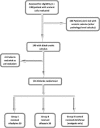Efficacy of nifedipine and alfuzosin in the management of distal ureteric stones: A randomized, controlled study
- PMID: 25378819
- PMCID: PMC4220377
- DOI: 10.4103/0970-1591.139572
Efficacy of nifedipine and alfuzosin in the management of distal ureteric stones: A randomized, controlled study
Abstract
Introduction: Stone disease is a significant and world-wide health problem. Recently, certain drugs have been used as a supplement to observation alone in an effort to improve spontaneous stone expulsion. We evaluated the efficacy of nifedipine and alfuzosin in the medical treatment of symptomatic, uncomplicated distal ureteral stones.
Materials and methods: This was a randomized controlled prospective study to determine the efficacy of alfuzosin and nifedipine as an adjunctive medical therapy, to increases the stone-expulsion rates in distal ureteric calculus of size ≤10 mm. Investigators and patients were blinded to the randomization scheme. Patients were randomly divided into three equal groups of 35 patients each. Patients in Group I received tablet nifedipine 30 mg/day, Group II received alfuzosin 10 mg/day and Group III was the control group received tablet diclofenac sodium. The patient blood pressure, stone position on imaging, number of pain attacks, time of stone-expulsion, hospital re-admission and any adverse events were assessed. Patients were followed-up weekly and continued until the patient was rendered stone free or up to 28 days. Statistical analysis was performed and P < 0.05 was considered to be significant.
Results: Stone-expulsion was observed in 60%, 85.7% and 20% patients in Group I, II and III respectively. A statistically significant difference was noted in between Groups I versus III, Groups II versus III and Groups I versus II (P < 0.0001, P < 0.0001, and P < 0.0315 respectively). The mean number of pain attacks was 2.91 ± 1.01 for Group I, 1.8 ± 0.83 for Group II, and 2.82 ± 1.12 for Group III, which is statistical significant in Groups II versus III, and Groups I versus II (P < 0.001 and P < 0.001). Hospital re-admission rate was less in treatment groups when compare to control group (P < 0.0001).
Conclusion: The use of alfuzosin and nifedipine as a medical expulsive therapy for distal ureteric stones proved to be safe and effective in term of increased stone-expulsion rate, reduced pain attacks and decrease hospital re-admissions.
Keywords: Alfuzosin; distal ureteral stones; medical expulsive therapy; nifedepine.
Conflict of interest statement
Figures
References
-
- Segura JW, Preminger GM, Assimos DG, Dretler SP, Kahn RI, Lingeman JE, et al. Ureteral stones clinical guidelines panel summary report on the management of ureteral calculi. The American urological association. J Urol. 1997;158:1915–21. - PubMed
-
- Lotan Y, Gettman MT, Roehrborn CG, Cadeddu JA, Pearle MS. Management of ureteral calculi: A cost comparison and decision making analysis. J Urol. 2002;167:1621–9. - PubMed
-
- Porpiglia F, Destefanis P, Fiori C, Fontana D. Effectiveness of nifedipine and deflazacort in the management of distal ureter stones. Urology. 2000;56:579–82. - PubMed
-
- Dellabella M, Milanese G, Muzzonigro G. Efficacy of tamsulosin in the medical management of juxtavesical ureteral stones. J Urol. 2003;170:2202–5. - PubMed
-
- Coll DM, Varanelli MJ, Smith RC. Relationship of spontaneous passage of ureteral calculi to stone size and location as revealed by unenhanced helical CT. AJR Am J Roentgenol. 2002;178:101–3. - PubMed
LinkOut - more resources
Full Text Sources
Other Literature Sources


